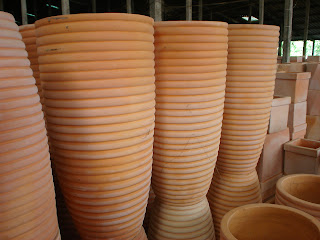The process starts with craftsmen making a negative blank from Plaster of Paris, this blank is carved then more Plaster of Paris is poured over the blank to make the mould (the pattern is then on the inside of the mould).
Clay is processed into a big slab then a wire is used to slice off layers to be pushed into the mould.
Finished moulds ready for use.
The moulds are split in two and big rubber bands are used to hold them together.
The Mould has had clay pushed into it, once dry, the mould is removed.
Another big pot with 1/2 the mould removed.
 The mould has been removed, the pot is left to dry before firing.
The mould has been removed, the pot is left to dry before firing.Worker pouring glaze over the pot before firing. Vietnam does not make a lot of Glazed Pots. They do not have gas fired kilns to produce the heat required for consistent quality.
Beehive Kilns down on the Mekong. This style of kiln has been used for hundreds of years.
View from the inside of the Kiln. The Kiln has a hole in the top for the excess heat to escape. The pots are stacked in the Kiln ready for firing.
Rice husks are tipped into a big tray and trickle down into the fire. The fire burns for at least 24 hours firing the pots.
Traditional Mekong Terracotta, you can tell by the colour the red/orange. The colour varies depending where the pot was in the Kiln, i.e. close to the fire it will be darker and further away it will be lighter.

By combining dark and light coloured clay and adding a few etchings, the look of the pot can be quite different.
Another look is swirling different coloured clays













No comments:
Post a Comment